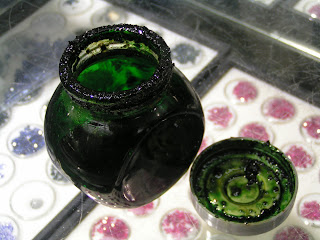Emeralds: Before the Oil, After the Oil, and After That

So my gemstone dealer D. and I decided to conduct an experiment. It was an ancient one, and he’s done it before of course, but I never had: we tested how an emerald would change if it got oiled. Oiling emeralds is as old as the hills, and it is common practice. Most emeralds on the market are oiled – an eye clean emerald that hasn’t been oiled is a rarity. I’ve read that cedar wood oil is a commonly used filler, but D. uses linseed oil, and a friend of his uses canola oil. The oil seeps into the stone through the cracks that reach the surface, thereby masking some of the flaws. Over time, the oil dries out and the cracks get exposed, but the process can then just be repeated. It is also reversible: if you want to get the oil out, just submerge it in acetone or denatured alcohol for a few days.
For our experiment, D. temporarily sacrificed a matched pair of 6mm round emeralds that he cut himself. Now the oil D. uses (but only when explicitly asked to enhance a stone) contains green dye. That’s technically a “no no” in the industry. Only colorless oils are considered acceptable, though who knows how many people also use dye. Here’s a picture of his oil:
 |
| Dyed Linseed Oil |
D. heated up the oil a little in order to liquefy it more. He also warmed up the stones a tad over a flame (but not too much, as they can fissure). That way, more oil gets into the stone, he claimed. This is how the emeralds looked before submersion:
 |
| Emeralds Before Oiling in Fluorescent Lighting |
Upon visible inspection, the stones had actually brightened up a bit. We were expecting them to darken because of the dye, but because this pair had a fair number of inclusions that were filled, and as a result they actually looked lighter (because more light could pass through would be my guess). You can also see – a little bit at least – that the number of black inclusions in the stones visibly lessened. My photos were not all taken in the same lighting conditions – I tried but it just didn’t pan out – and my camera isn’t the best, but I think you can tell the difference. Look especially at the stone on the right. It has a black line on the right top which has vanished in the second set of pics.
 |
| Emeralds After Oiling in Sunlight |
 |
| Emeralds After Oiling in Shade |
Now, D. wouldn’t want to sell an oiled emerald, so we had to get the oil back out. Also, I thought it was instructive to show that his can safely be done. So I put the stones into denatured alcohol for a couple of days, then just wiped them dry. I think they should be left in there some more, but already, you can see below the one larger black inclusion has re-appeared (the stone is on the left this time) and the coloring is a bit more grassy again.
 |
| Emeralds After Submersion in Alcohol, Photographed in Shade |
But when you buy an emerald, there are couple of things you can do:
1) Ask about treatments, and ask specifically about oil. In the worst case scenario, the seller won’t know. But what he does know, he has to disclose. Most likely, he will say that the stone has been oiled.
2) Loupe the stone, look for an oily film, or ask the seller to clean it in alcohol for you.
3) Under the loupe, look for cracks that reach the surface. The fewer such cracks there are, the less likely it is that the oil has changed the gem very much.
In terms of value, you get what you pay for: a heavily oiled stone has less value than an un-oiled one. Oiling changes the stone somewhat, but not drastically, as you can see here. Other fillers (epoxy and polymers) can achieve more dramatic changes. Those definitely need to be disclosed to the buyer, and if you can, stay away from them. A totally untreated, eye clean and richly colored Columbian emerald of even half a carat should cost you about $500 wholesale, so that gives you an idea. And good luck finding one! The emeralds I have, beautiful and sparkly as they are, all have at least a couple of inclusions that are visible to the naked eye. Some of my low grade cabochons are opaque (but I’ll sell those for much less). Also, the lighter stones, while they have less value in terms of color, are also cleaner and so they have higher brilliance. I prefer the slightly lighter ones for some reason, but this is really a matter of taste.
